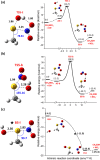Modeling predicts facile release of nitrite but not nitric oxide from the thionitrate CH3SNO2 with relevance to nitroglycerin bioactivation
- PMID: 39738238
- PMCID: PMC11685828
- DOI: 10.1038/s41598-024-80230-7
Modeling predicts facile release of nitrite but not nitric oxide from the thionitrate CH3SNO2 with relevance to nitroglycerin bioactivation
Abstract
Nitroglycerin is a potent vasodilator in clinical use since the late 1800s. It functions as a prodrug that is bioactivated by formation of an enzyme-based thionitrate, E-Cys-NO2. This intermediate reportedly decomposes to release NO and NO2- but their relative yields remain controversial. Hence, we determined barriers for NO and NO2- production from the model thionitrate, CH3SNO2, using comprehensive high-level quantum chemistry calculations [CCSD(T)//MP2/aug-cc-pVTZ]. We find that the sulfenyl nitrite, CH3SONO, readily releases NO on (S)O-N bond homolysis but CH3SONO formation from CH3SNO2 either by S-NO2 bond homolysis or concerted rearrangement faces prohibitively high barriers (ΔHcalc/ΔH‡calc > 42 kcal/mol). Dramatically lower barriers (ΔH‡calc ~ 17-21 kcal/mol) control NO2- release from CH3SNO2 by gas-phase hydrolysis or nucleophilic attack by OH- or CH3S- on the sulfur atom within the C-S-NO2 molecular plane. Moreover, attack by either anion along the S-NO2 bond results in barrierless NO2- release (ΔH‡calc ~ 0 kcal/mol) since a σ-hole (i.e., area of positive electrostatic potential) extends from this bond. Consistent with our high-level calculations, ALDH2 and GAPDH, enzymes implicated in nitroglycerin bioactivation via an E-Cys-NO2 intermediate, catalyze mainly or exclusively NO2- release from the prodrug.
Keywords: Bioactivation; Nitric oxide; Nitrite; Nitroglycerin; Thionitrate; Vasodilation.
© 2024. The Author(s).
Conflict of interest statement
Declarations. Competing interests: The authors declare no competing interests.
Figures








Similar articles
-
Vascular bioactivation of nitroglycerin by aldehyde dehydrogenase-2: reaction intermediates revealed by crystallography and mass spectrometry.J Biol Chem. 2012 Nov 2;287(45):38124-34. doi: 10.1074/jbc.M112.371716. Epub 2012 Sep 17. J Biol Chem. 2012. PMID: 22988236 Free PMC article.
-
Site-directed mutagenesis of aldehyde dehydrogenase-2 suggests three distinct pathways of nitroglycerin biotransformation.Mol Pharmacol. 2011 Aug;80(2):258-66. doi: 10.1124/mol.111.071704. Epub 2011 May 2. Mol Pharmacol. 2011. PMID: 21536753
-
Nitroglycerin metabolism in vascular tissue: role of glutathione S-transferases and relationship between NO. and NO2- formation.Biochem J. 1993 Jun 1;292 ( Pt 2)(Pt 2):545-50. doi: 10.1042/bj2920545. Biochem J. 1993. PMID: 8503888 Free PMC article.
-
Bioactivation of nitroglycerin by the mitochondrial aldehyde dehydrogenase.Trends Cardiovasc Med. 2006 Nov;16(8):259-65. doi: 10.1016/j.tcm.2006.05.001. Trends Cardiovasc Med. 2006. PMID: 17055381 Review.
-
Inorganic nitrite and nitrate in cardiovascular therapy: A better alternative to organic nitrates as nitric oxide donors?Vascul Pharmacol. 2018 Mar;102:1-10. doi: 10.1016/j.vph.2017.11.003. Epub 2017 Nov 22. Vascul Pharmacol. 2018. PMID: 29174923 Review.
References
-
- Ignarro, L. J. Nitric oxide donors and cardiovascular agents modulating the bioactivity of nitric oxide: An overview. Circ. Res.90(1), 21–28. 10.1161/hh0102.102330 (2002). - PubMed
-
- Thatcher, G. R. J., Nicolescu, A. C., Bennett, B. M. & Toader, V. Nitrates and NO release: Contemporary aspects in biological and medicinal chemistry. Free Radic. Biol. Med.37(8), 1122–1143. 10.1016/J.FREERADBIOMED.2004.06.013 (2004). - PubMed
-
- Yeates, R. A., Laufen, H. & Leitold, M. The reaction between organic nitrates and sulfhydryl compounds. A possible model system for the activation of organic nitrates. Mol. Pharmacol.28(6), 555–559 (1985). - PubMed
-
- Seabra, A. B., Ouellet, M., Antonic, M., Chrétien, M. N. & English, A. M. Catalysis of Nitrite generation from nitroglycerin by glyceraldehyde-3-phosphate dehydrogenase (GAPDH). Nitric Oxide35, 116–122. 10.1016/j.niox.2013.09.003 (2013). - PubMed
Publication types
MeSH terms
Substances
LinkOut - more resources
Full Text Sources
Research Materials
Miscellaneous

